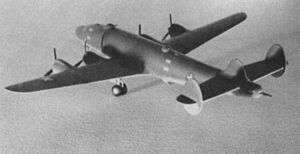Lockheed XB-30
| Lockheed XB-30 | |
|---|---|
 | |
| Scale model of the Lockheed XB-30 bomber concept. | |
| Role | Heavy bomber |
| Manufacturer | Lockheed Corporation |
| First flight | n/a |
| Status | Design only |
| Primary user | United States Army Air Forces |
| Number built | 0 |
| Developed from | L-049 Constellation |
The Lockheed XB-30 (company model L-249)[1] was the design submitted by Lockheed after the request by the United States Army Air Forces for a very heavy bomber, the same request that led to the Boeing B-29 Superfortress, the Douglas XB-31 and Consolidated B-32 Dominator.
Design and development
Around 1938, General Henry H. "Hap" Arnold, the head of the United States Army Air Corps, was growing alarmed at the possibility of war in Europe and in the Pacific. Hoping to be prepared for the long-term requirements of the Air Corps, Arnold created a special committee chaired by Brigadier General Walter G. Kilner; one of its members was Charles Lindbergh. After a tour of Luftwaffe bases, Lindbergh became convinced that Nazi Germany was far ahead of other European nations.
In a 1939 report, the committee made a number of recommendations, including development of new long-range heavy bombers. When war broke out in Europe, Arnold requested design studies from several companies on a Very Long-Range bomber capable of traveling 5,000 miles (8,000 km). Approval was granted on 2 December 1939.
Based on the design of the Lockheed L-049 (subsequently adopted by the Army Air Forces as the C-69), the L-249 never progressed past the design stage, mainly because Boeing had a huge head start with its Boeing B-29 Superfortress, using the same Wright Duplex-Cyclone radials as the XB-30 was intended to use. Only a scale model was built. Retaining the wings and tail surfaces of the Model 49, the Model 249-58-01 was to have had a new fuselage with up to six gun turrets (one in the nose, two above and two below the fuselage, and one in the tail) housing 10 .50-caliber guns—twinned up in each turret for the nose, dorsal, and ventral emplacements; and one 20-mm cannon for the tail defensive position. Ventral bomb bays were to accommodate eight 2,000-lb. (907 kg.) bombs.
Specifications (as proposed)
General characteristics
- Crew: 12
- Length: 104 ft 8 in (31.91 m)
- Wingspan: 123 ft 0 in (37.50 m)
- Height: 23 ft 9 in (7.25 m)
- Wing area: 1,646 ft² (153 m²)
- Empty weight: 51,616 lb (23,462 kg)
- Loaded weight: 85,844 lb (39,020 kg)
- Max. takeoff weight: 93,808 lb (42,640 kg)
- Powerplant: 4 × Wright R-3350-13, 2,200 hp (1,600 kW) each
Performance
- Maximum speed: 382 mph (615 km/h)
- Range: 5,333 mi (8,045 km)
- Service ceiling: 17,832 ft (5,440 m)
- Rate of climb: ft/min (m/s)
- Wing loading: 52 lb/ft² (255 kg/m²)
- Power/mass: 0.10 hp/lb (170 W/kg)
Armament
- Guns:
- 8× .50 in (12.7 mm) machine guns in four fuselage turrets
- 2× .50 in (12.7 mm) machine guns and
- 1× 20 mm cannon in remotely aimed tail turret
- Bombs: 16,000 lb
See also
- Related development
- Aircraft of comparable role, configuration and era
- Boeing B-29 Superfortress
- Consolidated B-32 Dominator
- Douglas XB-31
- Heinkel He 277
- Messerschmitt Me 264
- Related lists
References
- Notes
- ↑ Stringfellow and Bowers 1992, p. 31.
- Bibliography
- Stringfellow, Curtis K., and Peter M. Bowers. Lockheed Constellation. St. Paul, Minnesota: Motorbooks, 1992.
External links
| Wikimedia Commons has media related to Lockheed military aircraft. |